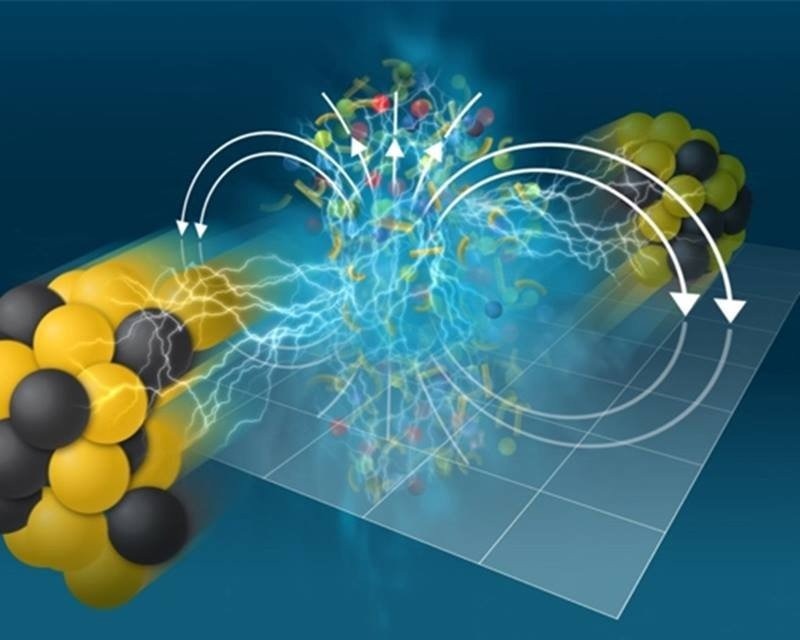In a recent study published in Physical Review. X, researchers from Brookhaven National Laboratory reported a novel approach that can be used to measure the electrical conductivity of quark-gluon plasma (QGP) and offer evidence for the presence of strong magnetic fields.

Collisions of heavy ions generate an immensely strong magnetic field that in turn induces electromagnetic effects in the quark-gluon plasma, a “soup” of quarks and gluons liberated from the colliding protons and neutrons. Image Credit: Tiffany Bowman and Jen Abramowitz/Brookhaven National Laboratory
Scientists have obtained the first direct evidence showing that powerful magnetic fields, generated during off-center collisions of atomic nuclei, can induce an electric current in a plasma known as "deconfined" nuclear matter. This plasma consists of quarks and gluons that are liberated from the confines of nuclear matter—protons and neutrons—during these collisions.
The magnetic fields in this deconfined nuclear matter are a billion times stronger than those of a typical refrigerator magnet, although their effects are typically challenging to detect.
The breakthrough in this study came from measuring how electrically charged particles are deflected as they emerge from the collisions. This finding not only confirms the presence of these intense magnetic fields but also introduces a novel method for measuring the electrical conductivity of the QGPs.
The Impact
Scientists can deduce the electrical conductivity of the QGP by observing how much the electromagnetic field deflects charged particles such as electrons, quarks, and protons. The degree of deflection directly correlates with the strength of conductivity.
Conductivity is a critical property of matter, yet measuring it within the QGP has been challenging until now. Gaining insights into the electromagnetic properties of the QGP could help physicists understand the phase transition between the QGP and ordinary nuclear matter, composed of protons and neutrons. Additionally, this research could pave the way for further studies into other magnetic phenomena within the QGP.
Summary
At the Relativistic Heavy Ion Collider (RHIC), a Department of Energy particle accelerator facility at Brookhaven National Laboratory, off-center collisions of atomic nuclei are expected to generate exceptionally powerful magnetic fields.
This phenomenon occurs as non-colliding positively charged protons whirl around when the nuclei sideswipe each other at nearly the speed of light. The resulting magnetic fields are anticipated to be stronger than those found in neutron stars and significantly more powerful than Earth's magnetic fields. However, directly measuring these magnetic fields within the QGP is difficult because this deconfined nuclear matter is extremely short-lived.
To overcome this, scientists employ indirect methods to study the QGP's properties. One such method involves using RHIC's STAR detector to track how the magnetic field affects charged particles as they emerge from the collisions.
The STAR physicists observed a distinctive pattern of charged-particle deflection, which could only result from an electromagnetic field and current induced within the QGP. This provided conclusive evidence of the magnetic fields' existence.
The extent of the deflection is directly linked to the strength of the induced current. Researchers will now use this methodology to measure the conductivity of the QGP, which could further our understanding of the phase transition from deconfined quarks and gluons to composite particles like protons and neutrons.
Funding
The National Science Foundation, the Department of Energy Office of Science, and several foreign organizations and agencies mentioned in the scientific publication provided funding for this study. The National Energy Research Scientific Computing Center (NERSC) at Lawrence Berkeley National Laboratory, the Scientific Data and Computing Center at Brookhaven National Laboratory, and the Open Science Grid consortium provided computing resources to the STAR team.
Journal Reference:
Abdulhamid, M. I., et al. (2024) Observation of the Electromagnetic Field Effect via Charge-Dependent Directed Flow in Heavy-Ion Collisions at the Relativistic Heavy Ion Collider. Physical Review. X. doi.org/10.1103/PhysRevX.14.011028.